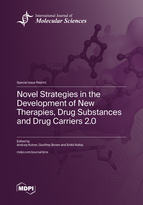Novel Strategies in the Development of New Therapies, Drug Substances and Drug Carriers 2.0
A special issue of International Journal of Molecular Sciences (ISSN 1422-0067). This special issue belongs to the section "Molecular Pharmacology".
Deadline for manuscript submissions: closed (15 December 2022) | Viewed by 50265
Special Issue Editors
Interests: medicinal chemistry; structure-activity relationship; synthetic strategies of pharmaceutical substances; design and synthesis of vitamin A and D anticancer analogs; structure analysis of nuclear receptor ligands
Special Issues, Collections and Topics in MDPI journals
Interests: the use of synthetic retinoids and vitamins D as drug substances; cancer and normal stem cells; anticancer therapies; blood cell development; abnormalities in cancer stem cells
Special Issues, Collections and Topics in MDPI journals
Interests: to understand and unveil biochemical and molecular mechanisms of the anti-tumourigenic effects of vitamin D and dietary calcium for colon cancer prevention; to examine the role of the calcium sensing receptor (CaSR) and of its natural and pharmacologic modulators in colon carcinogenesis and inflammation
Special Issues, Collections and Topics in MDPI journals
Special Issue Information
Dear Colleagues,
Currently, the need for the rapid development of effective and safe therapies for widespread diseases is stronger than ever. In developing new therapies, areas of current interest are the efficacy of drug development-related strategies, entirely new therapeutic molecules, new drug delivery systems, and personalized and digital medicine. There is also a need to integrate the various scientific disciplines and industrial activities that focus on these different aspects of drug research.
Volume 1.0 of the Special Issue “Novel Strategies in the Development of New Therapies, Drug Substances and Drug Carriers” (https://www.mdpi.com/journal/ijms/special_issues/ACCORD2021)has been highly successful, publishing 21 papers. We therefore aim to reopen this topic as volume 2.0 in the International Journal of Molecular Sciences (https://www.mdpi.com/journal/ijms, ISSN 1422-0067, IF 5.924, JCR Category Q1). This second Special Issue aims to promote synergy between research and activities in fields that contribute to conceiving and developing a new drug. This Special Issue is not limited to any specific aspect of drug development. On the contrary, it aims to cover the entire process at the molecular level to conform with the aims and scope of the journal. Topics include the identification of the molecular target of new drugs, studies of drug–protein interactions, studies of the modeling and optimization of functional activity, pre-formulation studies, new pharmaceutical carrier development, and preclinical development to clinical trials.
We would also like to draw your attention to the Interdisciplinary Conference on Drug Sciences, ACCORD 2022 (https://accord.wum.edu.pl/). All the participants of the ACCORD 2022 Conference will have the opportunity to publish a conference paper in this Special Issue. Manuscripts will go through the regular peer-review process of the journal.
All interested researchers are invited to submit review articles or original papers related to the topic of this Special Issue, guided by the “Aims and Scope”, “Instructions for Authors”, and the below keywords.
Prof. Dr. Andrzej Kutner
Dr. Geoffrey Brown
Dr. Enikö Kallay
Guest Editors
Manuscript Submission Information
Manuscripts should be submitted online at www.mdpi.com by registering and logging in to this website. Once you are registered, click here to go to the submission form. Manuscripts can be submitted until the deadline. All submissions that pass pre-check are peer-reviewed. Accepted papers will be published continuously in the journal (as soon as accepted) and will be listed together on the special issue website. Research articles, review articles as well as short communications are invited. For planned papers, a title and short abstract (about 100 words) can be sent to the Editorial Office for announcement on this website.
Submitted manuscripts should not have been published previously, nor be under consideration for publication elsewhere (except conference proceedings papers). All manuscripts are thoroughly refereed through a single-blind peer-review process. A guide for authors and other relevant information for submission of manuscripts is available on the Instructions for Authors page. International Journal of Molecular Sciences is an international peer-reviewed open access semimonthly journal published by MDPI.
Please visit the Instructions for Authors page before submitting a manuscript. There is an Article Processing Charge (APC) for publication in this open access journal. For details about the APC please see here. Submitted papers should be well formatted and use good English. Authors may use MDPI's English editing service prior to publication or during author revisions.
Keywords
- drug design and discovery, drug lead, drug-protein interactions, drug response, drug solubility
- antimicrobial drugs, antiviral drugs, antibiotics, anticancer drugs, cancer prevention
- molecular modeling, molecular mechanisms, spectroscopic imaging, crystallography, anti-crystal engineering
- preclinical study, pharmacokinetics, pharmacodynamics, pharmacognosy
- nuclear receptors, receptor agonist and antagonist, stem cells, activity profiling, viral proteases, vaccines, markers, and diagnostics
- drug carriers, dosage form, nanoparticles, 3D printing, dissolution testing









